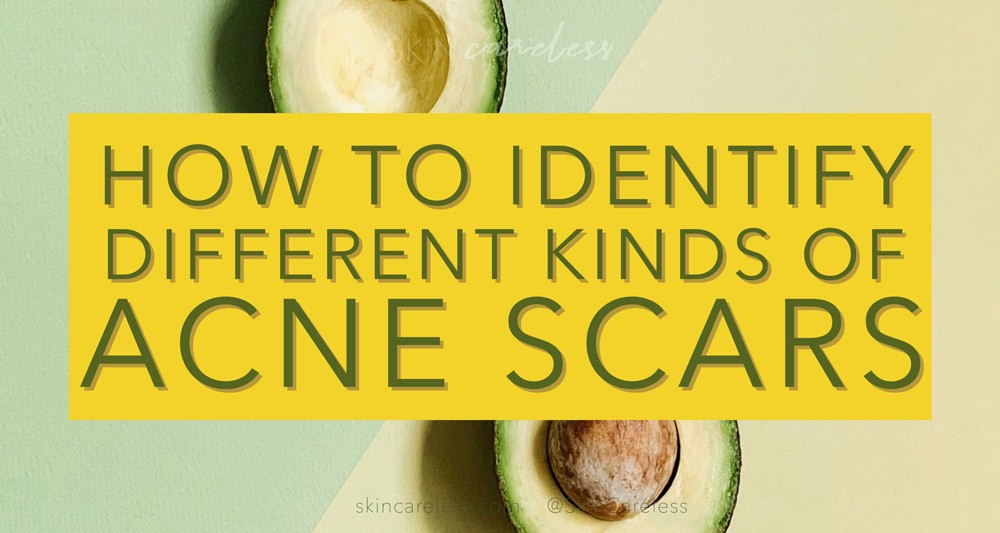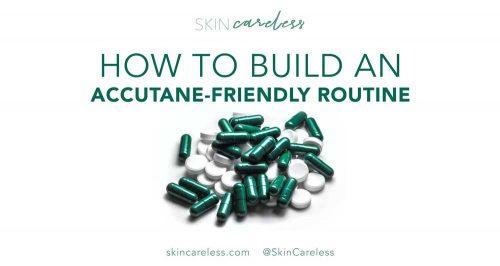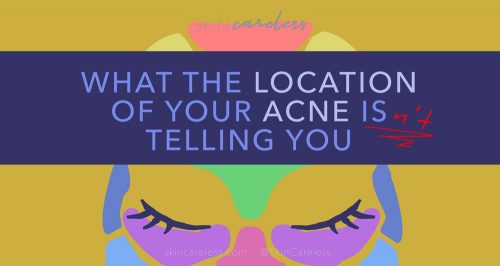Acne sucks. But what sucks even more is having your skin clear up, only to find you’ve got to deal with what’s left behind (as if pimples aren’t enough).
You might have a few small pink spots, dark marks, crater-like dents or raised skin toned bumps – or maybe all four! What gives?
The root cause of each of these marks left behind is different, which means they call for different treatments too. To understand how to get rid of your acne marks & scars, you must first understand what type they are. (If you already know what kind of acne marks you’ve got, skip ahead to my guide on treating them)
There’s more than one type of acne scar?
Many people don’t know that there are actually several distinct types of residual damage left behind after acne has gone away. They are each a symptom of a different response our skin has to trauma, which is individual from person to person. It’s important to learn and recognise the difference between Post-Inflammatory Erythema (PIE), Post-Inflammatory Hyperpigmentation (PIH) and true scarring, as each requires a very different approach to treatment. Read on to find out how to determine what you have and deal with it.
What’s Post-Inflammatory Erythema (PIE)?
No, not the delicious dessert. PIE stands for Post-Inflammatory Erythema. That’s a fancy term for ‘angry blood vessels after damage’. Your skin tried and succeeded in destroying the offending pimple, but unfortunately that heightened blood flow means excess and damaged capillaries. This results in a pinkish flat mark that blanches (disappear temporarily under pressure).
To test whether your marks are PIE, press the bottom of a clear glass against your skin. If you see them disappear, then it’s probably PIE. If they stay visible even under pressure, it’s more likely you’re looking at PIH.
What’s Post-Inflammatory Hyperpigmentation (PIH)?
PIH stands for Post-Inflammatory Hyperpigmentation. Unlike PIE, PIH has to do with melanin levels in your skin. After trauma, our skin tries to protect itself and sometimes this is via a heightened production of melanin. Melanin makes freckles and tans turn brown. It is also what gives colour to their skin of those who are naturally dark. As such, people with naturally deeper skin are more likely to suffer from PIH, due to their tendency to produce melanin.
PIH is flat and can be dark red or brown. It’s sometimes hard to tell apart from PIE. A simple solution is the glass test from above – PIH will not blanch.
What’s true scarring?
True acne scarring is damaged tissue left behind after your skin heals from the trauma of acne. It’s an accumulation of collagen that the body has produced to bind the wounded skin back together again.
You’ll know if you suffer from actual acne scars since your skin will have a change in skin texture and/or shape.
Acne scarring is very difficult to treat yourself, and will usually require the help of a dermatologist to administer treatments that will resurface and re-level your skin. There are two different sub-types of scars to know.
Atrophic scars
Atrophic scars are caused by abnormally low collagen production in the skin after trauma. This creates areas of damage that sink down, leaving holes or dents behind that are clearly seen in bright light. Atrophic scarring comes in several forms – icepick (narrow, pinprick holes), boxcar (crater-like dents with sharp edges) and rolling (bumpy but smooth).
Hypertrophic scars
Hypertrophic scars are caused by excess collagen produced after trauma. This then produces a raised bump above the skin. Often these scars are lighter than the surrounding skin, and may have a shiny appearance. A dramatic example of hypertrophic scars are keloids, which cause distinct, protruding scarring.
How to treat acne marks & scars
Thankfully, modern skin care is able to treat most types of acne marks and scars to one degree or another. Because there’s so much to it all, I’ve written a whole separate guide on everything to do with treating acne marks and scars over here.







I suffer from acne scars. I always have done. I’ve tried all sorts of medication, skincare products and diets. The next think I’m planning on trying is peels.
A very informative posts 🙂
Pinar | beautybakignbella.com
I’m sorry to hear of your scarring issues but good luck with the peels!
Wow this was so informative but also a very easy read I’ve got some old acne scars, little dents, on my temples. They are nothing too noticeable so not a big deal but I don’t love them either.
Thank you! I try to strike a balance 🙂 I’ve got some too, but nobody has perfect skin so I just leave them be!
[…] PIE & PIH, real acne scarring can be serious and nearly irreversible. The kind of acne that causes these […]
[…] be glowier with less flakiness and fine lines, slowed ageing and be finally free from acne and the resulting PIE for […]
[…] prevention is arguably an even more effective way to cure skin issues. Whether your concern is acne scarring or ageing or skin cancer, what not so many people know about are things that cause damage to their […]
[…] But studies have shown that those who are born to parents who suffered from acne presented acne earlier in their life and more severely. Moreover, they struggled with higher incidence of relapses after treatments like Accutane, and worse residual marks and scars. […]
[…] acne like papules, pustules and cysts aren’t glamorous or fun. They are painful and can leave serious scarring behind once they’re […]
[…] up the appearance of new skin from underneath. It also reduces pigmentation (be it freckles or PIH) and even fine lines. It is often recommended for use in people with acne prone […]
[…] marks (post-inflammatory erythema or PIE for short) from past acne are a constant bane of my life. They’re probably caused by a combination of […]
[…] of skin that have produced more pigment that normal (think freckles, sun spots, and acne marks aka. post-inflammatory hyperpigmentation) will slowly return to near-normal, given the proper amount of sunscreen […]
[…] ought to first identify the kind of acne marks & scars you have, as the treatment varies for each kind. This is because of the fundamental differences in how […]
[…] true. Left to its own devices, an imperfect healing process is all too common, and the remaining marks, flaky, tight, red, oily, or burnt skin are what takes days or even weeks to resolve – and […]
[…] To get started on treating common skin conditions, read more about identifying each one: dehydration and sensitivity, excess redness, acne, and scarring. […]
[…] Acne – be it minor non-inflammatory stuff or intense cystic inflammation – is probably one of the most well-known skin conditions, affecting most of us at some point in our lives. And when it’s over, there’s still the issue of acne scarring. […]
[…] redness can be brought on by exercise or leftover acne marks. In these cases it’s a sign of good blood flow and imminent […]